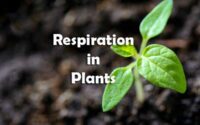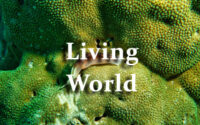Transport in Plants Questions and Answers
1. The ability to rise in thin tubes and the ability to resist a pulling force are respectively referred to as-
A. tensile strength and capillarity
B. adhesion and capillarity
C. cohesion and adhesion
D. capillarity and tensile strength
2. Which of the following is not a purpose of transpiration?
A. Helps in absorption and transport in plants
B. Prevents loss of water
C. Maintains shape and structure of plants by keeping the cell turgid
D. Supplies water for photosynthesis
E. Cools leaves surfaces
3. An osmometer is filled with 0.5M solution of Nacl in water. In which of the following solutions it must be immersed in order to make it shrink?
A. 0.5M solution
B. Distilled water
C. 0.05 M solution
D. 0.75 M solution
4. Physiological demonstration of osmosis is carried out by-
A. Bell jar experiment
B. Potometer
C. Thistle funnel whose mouth is tied with egg membrane
D. Thistle funnel whose mouth is tied with paper.
5. Stomata on the surface of the leaf, open by-
A. decreasing the solute concentration in the guard cells
B. increasing the solute concentration in the guard cells
C. weakening of the cell walls of the guard cells to allow them to stretch
D. increasing the water potential in the guard cells
6. The water potential of pure water is-
A. Zero
B. Less than zero
C. More than zero but less than one
D. More than one
7. Which of the following facilitates opening of stomatal aperture?
A. contraction of outer wall of guard cells
B. Decrease in turgidity of guard cells
C. Radial orientation of cellulose microfibrils in the cell wall of guard cells.
D. Longitudinal orientation of cellulose microfibrils in the cell wall of guard cells.
8. A few drops of sap were collected by cutting across a plant stem by a suitable method. The sap was tested chemically. Which one of the following test results indicates that it is phloem sap?
A. absence of sugar
B. Low refractive index
C. Alkaline
D. Acidic
9. Water vapour comes out from the plant leaf through the stomatal opening. Through the same stomatal opening, carbon dioxide diffuses into the plant during photosynthesis. Reason out the above statements using one of the following options.
A. Both processes can happen together because the diffusion coefficient of water and CO2 is different.
B. Both processes cannot happen simultaneously.
C. One process occurs during day time and the other at night
D. The above processes happen only during night time
10. A plasmolysed cell can be deplasmolysed by placing it in-
A. isotonic solution
B. saturated solution
C. pure water or hypotonic solution
D. hypertonic solution
11. When a molecule moves across a membrane independent of other molecules the process is called-(i) uniport (ii) Symport (iii) antiport
A. (i) only
B. (i) and (iii) only
C. (i) and (ii) only
D. (ii) and (ii) only
12. Apoplastic movement of water occurs exclusively through the-
(i) intercellular spaces
(ii) walls of the cells
(iii) plasmodesmata
(iv) cytoplasm
A. (i), (ii) and (iv) only
B. (iii) and (iv) only
C. (i) and (ii) only
D. (ii) and (iv) only
13. A column of water within xylem vessels of tall tress does not break under its weight because of
A. lignification of xylem vessels
B. positive root pressure
C. dissolved sugars in water
D. tensile strength of water
14. Root pressure develops due to-
A. passive absorption
B. active absorption
C. increase in transpiration
D. low osmotic potential in soil.
15. Guttation is a process of loss of water in-
A. liquid form containing dissloved minerals
B. liquid form without dissolved minerals
C. vapour form with minerals
D. vapour form without minerals.
16. The apoplast is located-
A. Outside the plasma membrane
B. In the entire cytosol
C. On both sides of plasma membrane
D. In the plastidial content
17. Which of the following statements about plasmolysis is/are true?
I. Plasmolysis occurs when water moves into the cell.
II. Cells shrink in hypotonic solutions.
III. If the external solution balances the osmotic pressure of the cytoplasm, it is said to be isotonic
A. I only
B. III only
C. II only
D. II and III only
18. Which of the following statements about the mass flow hypothesis is wrong?
A. It is the accepted mechanism for translocation of sugars from source of sink.
B. As glucose is prepared at source it is converted to sucrose.
C. Sucrose is actively loaded into a sieve tube,
D. The process of loading at source produces a hypotonic condition in the phloem.
19. Pick out the wrong statement.
A. Apoplast is the system of adjacent cell walls that is continuous throughout the plant.
B. Endodermis is impervious to water molecules.
C. Pinus seeds germinate and establish without the presence of mycorrhizae.
A. A and B
B. B and C only
C. C only
D. B only
20. Which of the following is not correct in mass flow hypothesis?
A. As hydrostatic pressure in the phloem sieve tube increases pressure flow stops and sap is accumulated in phloem.
B. The sugar is moved bidirectionally.
C. The sugar which is transported is sucrose.
D. Loading of the phloem sets up a water potential gradient that facilitates the mass movement in the phloem.
21. The cellular transport method which involves use of transmembrane proteins without energy expenditure is called-
A. Diffusion
B. active transport
C. exocytosis
D. facilitated diffusion
22. When a plant cell absorbs water, a pressure called _______ pressure develops inside the cell
A. Turgor
B. Wall
C. Osmotic
D. diffusion
23. Desalination of water is associated with-
A. osmotic pressure
B. elevation in temperature
C. decrease in freezing point
D. relative decrease in partial pressure
24. Bacteria cannot survive in a highly salted pickle because-
A. salt inhibits reproduction of bacteria
B. enough light is available for photosynthesis
C. they become plasmolysed and death occurs
D. nutrients in the pickle medium cannot support life.
25. Find out the correct pair of statements-
(i) In completely plasmolysed cell, pressure potential does not contribute to water potential
(ii) If a cell is placed in hypotonic solution for longer time, the cell membrane shrinks away from its cell wall.
(iii) Apoplastic system comprises inter-connected protoplasts
(iv) Polypeptides have more imbibing capacity than polysaccharides
A. (i), (iv)
B. (ii), (iv)
C. (i), (iv)
D. (ii), (iv)
26. Osmotic expansion of a cell kept in water is chiefly regulated by-
A. Vacuoles
B. Ribosomes
C. Plastids
D. Mitochondria
27. In which one of the following expenditure of energy is required?
A. Osmosis
B. Active transport d
C. Passive transport
D. Diffusion
28. Which of these is/are not a property of facilitated transport?
A. Requires special membrane proteins
B. Highly selective
C. Uphill transport
D. Required ATP energy
A. A and B only
B. A and C only.
C. C and D only
D. B and C only
29. Choose the wrong statement.
A. Cells swell in hypertonic solutions and shrink in hypotonic solutions
B. Water potential is the kinetic energy of water which helps in the movement of water.
C. The absorption of water by seeds and dry wood takes place by a special type of diffusion called imbibition.
D. Solute potential or Y is always negative.
30. The type of transport taking across the biomembranes wihout the help of protein is-
A. facilitated diffusion
B. active transport
C. simple diffusion
D. diffusion via symport
31. When the concentration of the solutes is low in plant cell, absorption of water is-
A. Retarded
B. Increased
C. Absent
D. normal
32. In a plant cell DPD is zero when it is-
A. Plasmolysed
B. Turgid
C. Incipient
D. Flaccid
33. When water moves out of the plant cell and the cell membrane of a plant shrinks away from its cell, then this condition is known as-
A. Plasmolysis
B. exosmosis
C. Ohydrolysis
D. dendosmosis
34. Which of the following criteria does not pertain to facilitated transport?
A. Transport saturation
B. Uphill transport
C. Requirement of special membrane proteins
D. High selectivity
35. Select the matched ones-
(i) Guttation-water loss in liquid phase
(ii) Adhesion-Mutual attraction between water molecules
(iii) Imbibition-Absorption of water by dry wood
(iv) Hypotonic solution-Cells shrink.
A. (i), (ii) and (iii) only
B. (ii) and (iv) only
C. (i) and (iv) only
D. (i) and (iii) only
36. The opening and closing of stomata is controlled by the activity of-
A. guard cells
B. mesophyll cells
C. epidermal cells
D. lenticels
37. Consider the following statements and select the correct option.
Statement A : Pure water has maximum water potential.
Statement B : The osmotic potential is zero in pure water.
A. Both statements are correct and B is not the reason for A.
B. Both statements are wrong.
C. Both statements are correct and B is the reason for A.
D. Both statements are correct
38. A thin film of water covering the soil particles and held strongly by attractive forces is called-
A. Hygroscopic
B. Capillary
C. run away
D. gravitational
39. What is not significant in osmosis –
A. Gravitational potential
B. Matric potential
C. Solute potential
D. Pressure potential
40. Pressure potential in a plasmolysed cell is
A. Positive
B. Zero
C. Remains same
D. Negative
41. Which factor does not contribute to stomatal opening-
A. Low pH
B. Light
C. Reduced CO2
D. Water
42. Maximum transpiration occurs in-
A. Mesophytes
B. Thallophytes
C. Bryophytes
D. Pteriodophytes
43. Which of the following statements is not true for stomatal apparatus?
A. Guard cells invariably possess chloroplasts and mitochondria
B. Guard cells are always surrounded by subsidiary cells.
C. Stomata are involved in gaseous exchange
D. Inner wall of guard cells are thick
44. Apoplastic path for the transport of water in root is through-
A. intercellular spaces
B. intercellular spaces and cell walls
C. cell walls only
D. intercellular spaces, cell walls and endodermis
45. Osmotic pressure of a pure solvent at 25°C and 1 atm is always-
A. less than its solute
B. more than its solution
C. negative
D. zero
46. The water potential and osmotic potential of pure water are-
A. 100 and 200
B. 100 and zero
C. zero and 100
D. zero and zero
47. Which condition favours guttation-
A. High humidity
B. low humidity
C. More transpiration
D. Bright sunlight
48. In higher plants, continuity of cytoplasm from one cell to its neighbouring cells is established through
A. Apoplast
B. Leucoplast
C. chloroplast
D. symplast
49. The relationship Πv = nRT is not obeyed by –
A. concentrated solution
B. dilute solution
C. extremely dilute solution
D. all the above
50. Living cells placed in isotonic solution (0.9% saline) retain their size and shape. This is based on the concept of-
A. Osmosis
B. Diffusion
C. facilitated diffusion
D. transpiration



